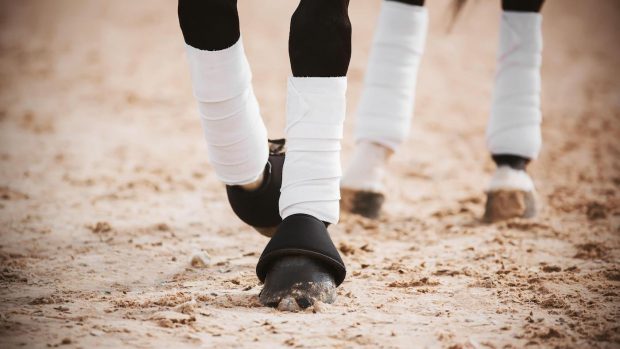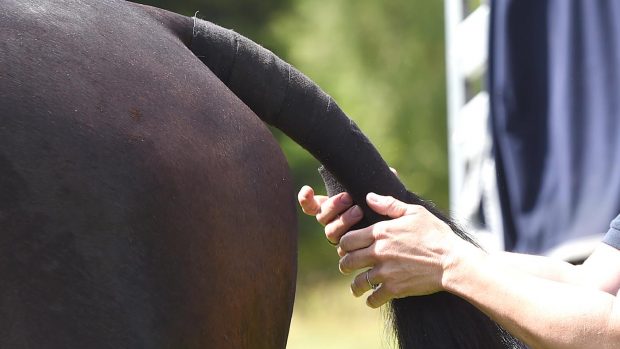Bandaging is a skill acquired with practice. It has a variety of purposes — warmth, support, protection and immobilisation. Whatever the specific use of the bandage, it must be correctly applied to give firm, even pressure. If a bandage is too tight, it can restrict the circulation and lead to the formation of pressure sores or serious injury such as tendon damage. If a bandage is too loose, it will not serve its purpose and can become a hazard to the horse.
Bandaging the limb
Essentially, any bandage should have three layers.
On the inside is a non-stick clean dressing, which is attached to the wound. If there is no wound and you are applying a protective or support bandage, this layer is unnecessary.
The middle is the crucial padding that protects any injury, absorbs discharge, controls swelling and helps prevent bandage rubs. If this is skimped on or forgotten, the horse will suffer.
The third is the outer wrapping, which holds the bandage in place and provides extra support.
When a bandage is applied to the leg, it is vital that sufficient padding, such as gamgee or cotton wool, is used underneath to distribute the pressure evenly. Before the bandage is applied, any wrinkles in the padding should be smoothed out to avoid creating pressure points.
When the bandage is applied, half its width should be overlapped on each turn, which will also ensure that the pressure is evenly distributed. If ties or Velcro fastenings are used to secure it, they should be fastened at the same pressure as the rest of the bandage, with any knots lying on the outside of the leg, thereby avoiding exerting pressure on the tendons at the front and back of the limb. It is safer to use sticky tape.
It is important that the padding protrudes from the top and the bottom of the bandage, to prevent it rubbing on unprotected skin.
If a bandage is applied too tightly or is uneven, it is possible to cause pressure sores in the underlying skin, which will result in unsightly white hair growing on the horse’s leg when it has healed. In more severe cases, it is possible to cause a “bandage bow”, where the underlying tendons are damaged due to the excessive pressure.
If for any reason a horse is not bearing full weight on the affected leg, the opposite leg, or, if necessary, all three limbs, should have support bandages applied.
Checking bandages
Bandages should be checked twice daily to ensure they are neither too tight nor too loose. You should just be able to insert two fingers between the top of the bandage and the skin. If this is not possible, the bandage may be too tight. However, if it is easy to insert two fingers, with the bandage sagging away from the fingers, it may be too loose and liable to slip.
Wounds
When bandaging a wound, the same basic principles must be followed, although it is also necessary to consider the covering to be applied to the wound. A non-adherent dressing should be used so that it does not stick to the wound surface — for example, Melolin or Allevyn.
The dressing will also provide additional padding over the surface of the wound and should be secured in place. An ideal base for this purpose is a thin layer of cotton wool such as Soffban or Orthoban, which cannot be applied too tightly, as it will tear if any tension is used when applying it.
The gamgee or cotton wool padding should be applied over the top of this layer, and secured in place with a conforming cotton bandage. Then the third layer of self-adhesive bandage material, for example, Vetwrap, may be applied to help secure the bandage.
Awkward areas
Although applying a bandage to the lower limb (cannon bone and pastern) can be relatively straightforward, other areas pose more of a challenge. When a bandage is applied to either the hock or the knee, the constant movement in the joint can lead to it loosening and slipping down the leg, which will create pressure points in the skin and structures beneath.
In addition, care must be taken to provide adequate protection for the accessory carpal bone on the forelimb, and the point of the hock in the hindlimb. These are bony prominences with very little soft tissue, and are therefore extremely susceptible to the development of pressure sores.
There are proprietary elasticated zip-up “stockings” available in a range of sizes, designed for use specifically on knees, hocks or fetlocks. All that is required is a non-stick dressing over the wound, secured in place by a thin conforming layer of cotton, before the stocking is applied. In the case of knee and hock wounds, a stable bandage is applied to the lower limb to provide additional support and prevent the stocking from slipping down the leg.
Tubular bandages, such as Tubigrip, can also be used to hold a dressing over awkward areas such as joints. The bandage is secured to the hair above the joint with an adhesive dressing such as Elastoplast. A stable bandage is applied to the lower limb to secure the bottom of the tubular bandage. These should be used with care, as repeated application and removal of adhesive dressings can make the skin sore.
Specialist bandages
While it may not appear to be a specialist type of bandage, a tail bandage needs careful application. It is the only bandage that is applied directly to the skin with no padding layer underneath, and because of this it is vital that it is applied correctly.
A tail bandage is frequently left on for long periods of time, depending on the length of a journey, and, if it is applied too tightly, can restrict the circulation in the dock. This may lead to loss of tail hair and sloughing of skin and in serious cases, where the blood supply is completely occluded, the tail may have to be amputated.
Following abdominal surgery, for example, for colic, a belly band may be applied. This is a large bandage that goes all the way round the horse’s abdomen to provide increased support to the incision and prevent contamination of the incision, for example, from bedding in the stable if the horse lies down.
The belly band can either be a proprietary large elasticated bandage applied over a gamgee pad to protect the incision, or it may be an adhesive bandage wrapped around the abdomen over a gamgee pad. If a belly band is used for any length of time, padding must also be applied over the spine to prevent the development of pressure sores.
Another specialist bandage is the Robert Jones bandage, which offers very firm support and is used for:
- the stabilisation of certain fractures
- to support an injured limb
- to protect the limb following surgery
It can be applied to either the whole limb or just the lower half. A non-stick dressing is placed over the wound and held in place by a layer of orthopaedic padding. A thick layer of cotton wool is then applied, secured and compressed by a conforming cotton bandage. This step is repeated a number of times until a solid, support bandage is achieved. A final, adhesive layer is then applied.



